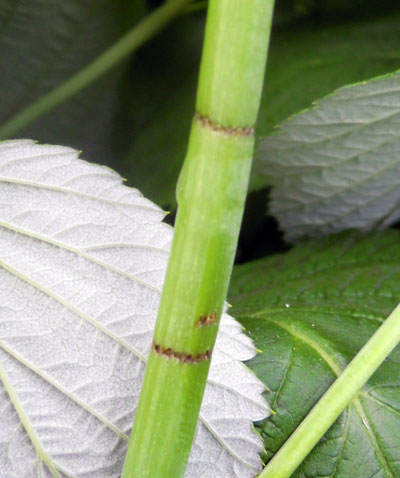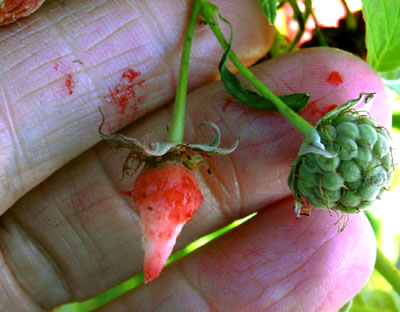Southwest Michigan fruit regional report – July 2, 2013
A rainy week made for poor conditions for applying pesticides.
Weather
Last week was warm and wet. High temperatures were in the upper 80s and lows in the upper 60s. Storms with heavy rain crossed the region Tuesday, Wednesday and Thursday (June 25-27). More rain fell over the weekend. These storms were scattered so rainfall amounts varied greatly across the region. Rainfall totals varied from 1 to 4 inches and intense, heavy rain may have overwhelmed automated rain gauges because many growers report receiving almost twice those totals for the week. Water is standing in areas with poor drainage. We continue to be a week behind the five-year average in growing degree days (GDD). Check your local weather station and conditions at Enviro-weather.
Southwest Michigan GDD summary from March 1 to June 30
|
Station |
GDD 42 F |
GDD 45 F |
GDD 50 F |
|
Benton Harbor (SWMREC) |
1557 |
1334 |
999 |
|
Fennville (TNRC) |
1425 |
1209 |
886 |
|
Average for the region |
1547 |
1325 |
992 |
|
GDD increase last week |
201 |
179 |
145 |
Tree fruit
An apple thinning and sweet cherry workshop will be held July 9 at the Clarksville Research Center east of Grand Rapids, Mich. Japanese beetle adults appeared in the area in mid-June and continue to be found in relatively low numbers. Spotted wing Drosophila adult male and female flies are being caught in low numbers, but should increase sharply as small and tree fruits approach harvest. Growers should be on the lookout for brown marmorated stink bugs and report sightings to local Michigan State University Extension county offices for verification. Potato leafhoppers are becoming more common and growers should protect vulnerable plants, especially young apple and plum trees.
Apricot harvest is continuing with midseason varieties.
Peach pits have hardened and fruit size is increasing rapidly. Harvest could begin next week for the very earliest varieties such as PF1, which is now starting to develop red skin color in sandy sites in Berrien County. High crop loads and wet conditions promoting foliage growth are slowing fruit ripening in some sites. Bacterial spot symptoms such as leaf spotting, leaf yellowing, leaf drop and fruit gumming are significant in some sandy sites with susceptible varieties. Brown rot control programs and possibly insect control of spotted wing Drosophila will need to be ramped up as we approach harvest. Oriental fruit moth trap catches are rising again in some sites and not in others, but the timing is right for the start of the second generation flight. X-disease symptoms are showing up in peaches. Trees showing X-disease should be marked for removal.
Sweet cherry harvest is continuing with mid-season varieties such as ‘Ulster’, ‘Hedelfingen’, Summit and ‘Kristin’. Birds are feeding on colored fruit. Fruit flavor has been quite good with some typical fruit cracking due to rain. Disease concerns are cherry leaf spot and brown rot, and cherry fruit fly and spotted wing Drosophila are the insects to monitor and manage.
Tart cherry fruits are colored and sizing well. Hand harvest for farm markets and U-picks are ongoing. Mechanical shaker harvesting of large orchards is starting this week, depending on the site. Growers should protect against fruit flies, including the new spotted wing Drosophila, and the diseases cherry leaf spot and brown rot.
Plum fruit are 0.875 (Stanley) to 1.5 inches (Shiro) in diameter at the Southwest Michigan Research and Extension Station (SWMREC). Fruit in some orchards are continuing to show more water-soaked bacterial spot symptoms. Growers should check for signs of brown rot that has been seen on green fruit in some orchards recently. Fruit with insect and bacterial spot symptoms will be more prone to brown rot infections.
Apple fruit at SWMREC are 1.5 inches in diameter for ‘Golden Delicious’ and nearly 2 inch for ‘Zestar and Red Delicious. Current wet weather will encourage sooty blotch and fly speck disease development on apples and pears. Obliquebanded leafroller larvae can be found in tender leaf tissue at the ends of terminals. Trap catches for oriental fruit moth and codling moth flight vary considerably from orchard to orchard, indicating that control decisions should be based on local trap catches and monitoring. Spotted tentiform leafminer mines can be found in low numbers. Green apple aphids are common in some Golden Delicious orchards. Yellow sticky traps for monitoring apple maggot fly emergence should be deployed soon.
Pears fruit are approximately 1.5 inches in diameter. Growers should continue monitoring for pear scab symptoms, fire blight and pear psylla activity.
Small fruit
In grapes, the Concord grape berry weight model predicts that grapes will be at half of their final weight at 1,200 GDD base 50 past April 1. On Monday, July 1, we reached 1,032 GDD base 50 at the Benton Harbor Enviro-weather station, and 1,057 base 50 for Berrien Springs. It appears we will reach 1,200 sometime around July 7-9 for both locations.
Trap catches for grape berry moth have been low so far in the vineyards we monitor, with an average of two to 12 adult males per trap. Check the grape berry moth model on Enviro-weather for the station closest to your vineyard. The Enviro-weather grape berry moth model predicts grape berry moth development and the start of second, third and fourth generation egglaying (810; 1,620; and 2,430 GDD base 47 F from the biofix of wild grape bloom, respectively). We set biofix for grape berry moth in some parts of Berrien County on May 25, and May 26-28 in other parts of Berrien and Van Buren counties. For Berrien Springs, using a biofix date of May 25, 752 GDD has accumulated as of July 1. The 801 GDD mark is predicted to occur on July 4 for biofix dates of May 24 to 27, and July 5 for a biofix date of May 28.
We are at or approaching berry touch for ‘Niagara’ and ‘Concord’ grapes in some vineyards. Excellent coverage of clusters before bunches close is needed to achieve optimum control of grape berry moth. Insecticides that are active on eggs and young larvae, such as Intrepid, Alticor and Belt, should be applied at 810 GDD, but the application of broad spectrum products, such as Imidan, should be delayed until 910 GDD.
Growers of hybrid and vinifera grapes should watch for Japanese beetle activity to begin soon. We still have not detected Japanese beetle adults in the vineyards we monitor. However, three indicator plants that usually signal the beginning of Japanese beetle activity – basswood, little leaf linden and common elderberry – are near or at full bloom now in Berrien County.
We are still in the stage of fruit development that is critical for disease control. Keep developing fruit protected against Phomopsis and black rot at least through bunch closure. The continuing wet weather is favorable for black rot infections. The black rot model on Enviro-weather shows that the most recent infection period for black rot occurred June 30-July 1at Berrien Springs and Lawrence. Certain vinifera cultivars remain susceptible to black rot through veraison.
The first symptoms of both downy mildew and powdery mildew appeared last week in an untreated sentinel plot used for monitoring disease at SWMREC. Spore masses of downy mildew are appearing on clusters of susceptible cultivars in these plots. Consult the 2013 Michigan Fruit Management Guide (E154) for recommended fungicides.
In blueberries, early varieties are ripening and early hand harvest has begun. Growers with ripening fruit need to begin scouting for blueberry maggot and spotted winged Drosophila (SWD). We detected the first male and female SWD in a trap adjacent to a blueberry planting we monitor in Benton Harbor from trap catches collected during the week of June 21-27.
Growers should also be applying sprays to suppress anthracnose and alternaria fruit rots. The Anthracnose Disease Prediction Model Handout posted at the Michigan Blueberry Facts website explains how to use the anthracnose prediction model on Enviro-weather. Note that the output for this model has the earliest rains at the top, so the most recent rains are at the bottom of the page.
Strawberry harvest ended last week at most farms. Many growers have begun renovation.
Bramble harvest is underway with the harvest of summer red raspberries and black raspberries. Powdery mildew has been found on foliage in high tunnel raspberries. Other insects observed include raspberry cane borer, raspberry sawfly and potato leafhoppers. Canes infested by raspberry cane borer have wilting tips and two dark rings of punctures on the canes where eggs have been laid. Cut off and destroy the wilted tips below the rings as soon as this damage is noticed.

Rings of puncture marks on raspberry cane where eggs
have been laid by raspberry cane borer.
Photo credit: Diane Brown, MSU Extension
The cultivar ‘Polka’ seems particularly sensitive to potato leafhopper injury, showing yellowed leaf edges and distorted leaves. No SWD were found in the raspberry high tunnel this week, but growers should be scouting for SWD. Both male and female SWD were trapped at two locations in Berrien County last week – one pair in the Benton Harbor area, and another pair near Berrien Center. One of the signs of infestation in raspberry is a red stain present on the receptacle when the raspberry is picked. Insecticides to control SWD in brambles and other insect problems should not be applied while bees are actively foraging.

Raspberry receptacle with red stains is indicative of fruit
infestations by SWD. Photo credit: Diane Brown, MSU Extension
Upcoming meetings
A hop production workshop is scheduled for August 7 at SWMREC from 8:30 a.m. until 3:30 p.m.



 Print
Print Email
Email




